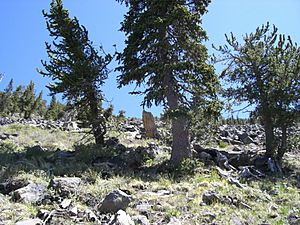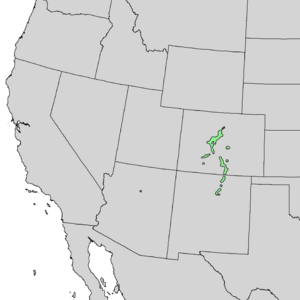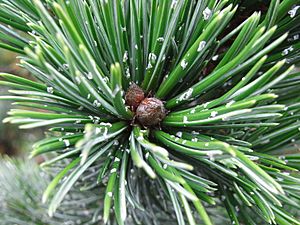Rocky Mountain bristlecone pine facts for kids
Quick facts for kids Rocky Mountain bristlecone pine |
|
|---|---|
 |
|
| Pinus aristata on Humphreys Peak, Arizona | |
| Conservation status | |
| Scientific classification | |
 |
The Rocky Mountain bristlecone pine (scientific name: Pinus aristata) is a very old tree. It is also called the Colorado bristlecone pine. This special tree grows naturally in the United States.
You can find it in the Rocky Mountains in Colorado and northern New Mexico. There are also some groups of these trees in Arizona, near the San Francisco Peaks and the Grand Canyon. These trees usually live in very high places. They grow from about 7,000 to 13,000 feet high. They like cold, dry weather, often right where trees stop growing.
Contents
What Does the Bristlecone Pine Look Like?
The Rocky Mountain bristlecone pine is a medium-sized tree. It can grow to be about 8 to 20 feet (2.4 to 6.1 meters) tall. It can also spread out 10 to 15 feet (3 to 4.6 meters) wide. The trunk of the tree can be different sizes. Its bark is thin, grey-brown, and scaly at the bottom.
The leaves of this pine are called 'needles'. They grow in groups of five. Each needle is strong and about 2.5 to 4 cm long. They are dark green or blue-green on the outside. The inside of the needles has a bright white stripe.
Cones and Seeds
The tree's cones are shaped like an oval cylinder. They are 5 to 10 cm long and 3 to 4 cm wide when closed. At first, they are purple. After about 16 months, they turn yellow-brown. Each scale on the cone has a small, stiff spine. This spine is about 4 to 8 mm long.
When the cones are ready, they open up to 4 to 6 cm wide. They release their seeds right away. The seeds are small, about 5 mm long. They have a wing that is 10 to 20 mm long. Most of these seeds are carried by the wind.
Some seeds are also spread by a bird called Clark's nutcracker. These birds take seeds from the open cones. They store many seeds to eat later. If some stored seeds are not eaten, they can grow into new trees.
Special Features
This bristlecone pine is different from other bristlecone pines. Its needles usually have only one resin canal. These canals are often broken. This makes small white resin spots appear on the needles. These spots look a bit like 'dandruff'. This is a special sign of the Pinus aristata. No other pine tree has this feature.
How Long Do They Live?
These trees live for a very long time. However, they do not live as long as another bristlecone pine called Pinus longaeva. The oldest known Rocky Mountain bristlecone pine is in Colorado. In 1992, it was found to be 2,435 years old by counting its tree rings. It was estimated to be 2,480 years old in total. But most of these trees usually live for less than 1,500 years.
This tree was once thought to be a type of Pinus balfouriana. Now, Pinus aristata is known as one of three types of bristlecone pines. It is also called the foxtail pine or hickory pine.
Growing Bristlecone Pines
The Rocky Mountain bristlecone pine is the most common bristlecone pine grown by people. It is a very pretty tree that grows slowly. It is good for small gardens in cold places.
However, these trees do not live as long in gardens as they do in the wild. They usually live less than 100 years. This is because the warmer and wetter conditions in most towns can cause their roots to rot.
See also
In Spanish: Pino de Colorado para niños



